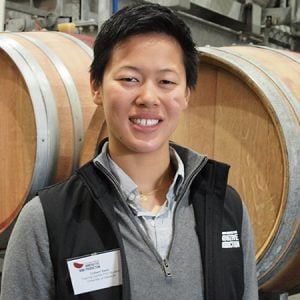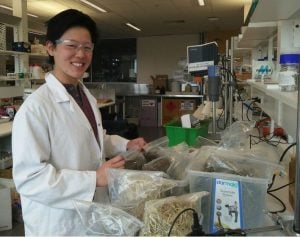Could you tell us a bit about yourself and your academic background?
 I grew up in Carver, a small town south of Boston, Massachusetts that is famous for its cranberry production. I pursued a B.S. in Psychology (otherwise known as the neuroscience track) at the University of Massachusetts Amherst,with the goal of medical school and being a neurologist on the radar.
I grew up in Carver, a small town south of Boston, Massachusetts that is famous for its cranberry production. I pursued a B.S. in Psychology (otherwise known as the neuroscience track) at the University of Massachusetts Amherst,with the goal of medical school and being a neurologist on the radar.
Human movement has always fascinated me and that is one of the reasons I love sports that challenge us in a largely technical way, which includes swimming, rock climbing, and dancing. My goal was to have clinical and research aspects to my position as a neurologist, both of which would be directed toward assisting people regain their range of motion and by extension, their sense of self and connections to other people.
While others were applying to medical school toward the end of undergrad, I simply did not feel like it was the right path to pursue. I was actively researching typical occupations for which chemists were suitable, and they were largely pharmaceutical, toxicological, environmental, industrial, or academic—all analytical—in nature. However, there was also this other food—and later, wine—side that inspired ideas and potential applications that I had never previously thought of, and so I decided to jump into it!
I applied to a Master of Professional Studies (MPS) in Food Science and Technology at Cornell University (1-year duration), with the end goal of working in wine production. As a pre-requisite to matriculation in January, I was required to work as a harvest intern from July-November, and I found myself at a winery in the Sierra Foothills region of California. Following several months of punch-downs, racking, and cleaning, my romanticized notion of winemaking had dissipated, but I was still interested in researching the chemistry relevant to wine production, and so I decided to accept the offer to study at Cornell.
From my first semester studies, particularly in wine chemistry, I became really interested in how chemical compounds interact to produce flavours and different sensory profiles in wine matrices, especially given all of the sources of wine flavour compounds, the many winemaking decisions that influence their abundance in the finished wine, and the inherent subjectivity of consumer perception.
Between semesters at Cornell, I worked with NEC Labs in Princeton, NJ, USA. A team of computer scientists, engineers, and analytical chemists had created an Fourier-transform infrared spectroscopy (FTIR)-based sensor, and they were curious about whether this device could be adapted by the food and wine industry. My position involved identifying areas this could be of assistance, and the discussion and evaluation of some promising applications became the content of my project paper required for completion of the MPS program. These promising applications included the reliable differentiation of grape varieties, wine regions and cool or warm climates, as well as the prediction of wine quality and sensory profiles.
During my last semester at Cornell, I met Dr. Keren Bindon and Dr. Dimi Capone over dinner while they were at the university to give a seminar in August 2017, and it’s fair to say that their work and several other publications from AWRI and the University of Adelaide researchers drew my eye toward the Australian wine industry and research community.
Following that meeting, I received an email from our graduate program coordinator, which included an attachment of a pamphlet outlining the new ARC Training Centre for Innovative Wine Production and its affiliated research projects. While I had been on the fence about whether to continue with academia or not, I had the feeling that if any place or opportunity could point me in the right direction, it would be this one. The post with the Centre offered the hybrid of developing my skills as a research professional in an encouraging learning environment, providing access to one of the biggest wine research institutes in the world, and collaborating with a fleet of colleagues, all of whom researched questions pertaining to wine and its intersections with microbiology, chemistry, engineering, and/or sensory evaluation.
Could you introduce us to your project and what it involves?
 The overall goals of my research are to overcome smoke taint in vineyards, via the development of a detection method paired with an effective preventative strategy.
The overall goals of my research are to overcome smoke taint in vineyards, via the development of a detection method paired with an effective preventative strategy.
Smoke taint refers to the undesirable burnt, medicinal, and charred meat aromas and ashy aftertaste that dominate wine sensory profiles following grapevine exposure to smoke.
We are aiming to test whether a commercial sensor built for the purposes of wildfire detection can be adapted for the purpose of creating a smoke taint risk profile. It is not currently known how much smoke is necessary for viticulturists and winemakers to be justifiably concerned about smoke taint, and this makes effective, timely fruit management strategies difficult. The other part of my research involves the development of a preventative strategy to limit the uptake of smoke-derived volatile compounds by the grapevines.
What can you see yourself doing in the future?
I’m not sure that anyone can predict their future occupation with certainty, especially given the fact that our job market and work-life structure is increasingly transient, my preferences, skills, and limitations will likely change over time, and unexpected opportunities, like the one I am pursuing now, cannot be seen from the present. However, I am confident that my experience in the Centre will provide me with a wide range of project management, research, networking, writing, analytical, and collaborative skills (among many others) that are applicable to most desirable work positions, regardless of their specific content.
In the immediate future, while I am in Australia, I am really looking forward to visiting Tasmania and taking camping adventures in the more wild regions of Australia!
